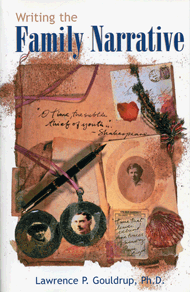 Eventually, most genealogist come to realize that years of collected data, records, diaries, pictures, heirlooms, and more cannot endlessly pile up in boxes and still serve living or future generations. Organizing and sharing volumes of data in a practical and digestible manner becomes a problem. The solution for many is the publishing of a family history book. However, putting a book together can seem like an overwhelming task. With help, some of the fear around writing and compiling a book can be alleviated. The most common type of family history book is a narrative. Writing a Family Narrative was created to help genealogist bring their experience and research together with the necessary help to produce that family history book. Learn from author, Lawrence P. Goudrup, “how to compose a controlled and focused rendition of your family’s story.”
Eventually, most genealogist come to realize that years of collected data, records, diaries, pictures, heirlooms, and more cannot endlessly pile up in boxes and still serve living or future generations. Organizing and sharing volumes of data in a practical and digestible manner becomes a problem. The solution for many is the publishing of a family history book. However, putting a book together can seem like an overwhelming task. With help, some of the fear around writing and compiling a book can be alleviated. The most common type of family history book is a narrative. Writing a Family Narrative was created to help genealogist bring their experience and research together with the necessary help to produce that family history book. Learn from author, Lawrence P. Goudrup, “how to compose a controlled and focused rendition of your family’s story.”
This book was written specifically for the genealogist and those hoping to write about themselves or their own family’s history. Though not spelled out in the table of contents or on the cover, here is what the reader can expect to learn from reading this book:
- Planning: writing a family narrative requires careful preparation to avoid being tedious or unappealing
- Scope: avoid beginner pitfalls like trying to tell the complete story, when focus on specific issues, people, or periods is better
- Focus: commitment to the specific theme and selecting only those facts from one’s genealogical data that contribute to the narrative in a positive way
- Evaluation: deciding what is truth and what it not, and what truth to include in order to properly tell the story
- Avoiding Fiction: avoiding tendency to “put words in their mouths;” avoid adding opinions, ideas, or details to embellish a story but lack truth
- Immersion: put at least the same effort into organizing facts and into the writing process that went into the original research. “Leave no leaf unturned,” “leave no lead unfollowed.”
Writing a Family Narrative helps the reader examine aspects of family information to determine relevancy and the relevant details necessary to construct a story without undue embellishments. For example, sections include “How did the family earn its money and how did it spend it?” and “What did the family consider important or valuable?” The book also focuses on important writing techniques such as characterization, plot conflict, and point of view.
Each section provides clear instructions and is filled with examples. The book is easy to read and the examples help take the reader step-by-step through the literary process.
Contents
Preface
Chapter One What is Family History?
Chapter Two Using Genealogical and Local History Records to Write the Historical Exposition
Chapter Three Writing the Narrative
Chapter Four Point of View
Chapter Five Some Finishing Touches
Writing a Family Narrative is available from Family Roots Publishing; Item #: TP274, Price: $12.69.